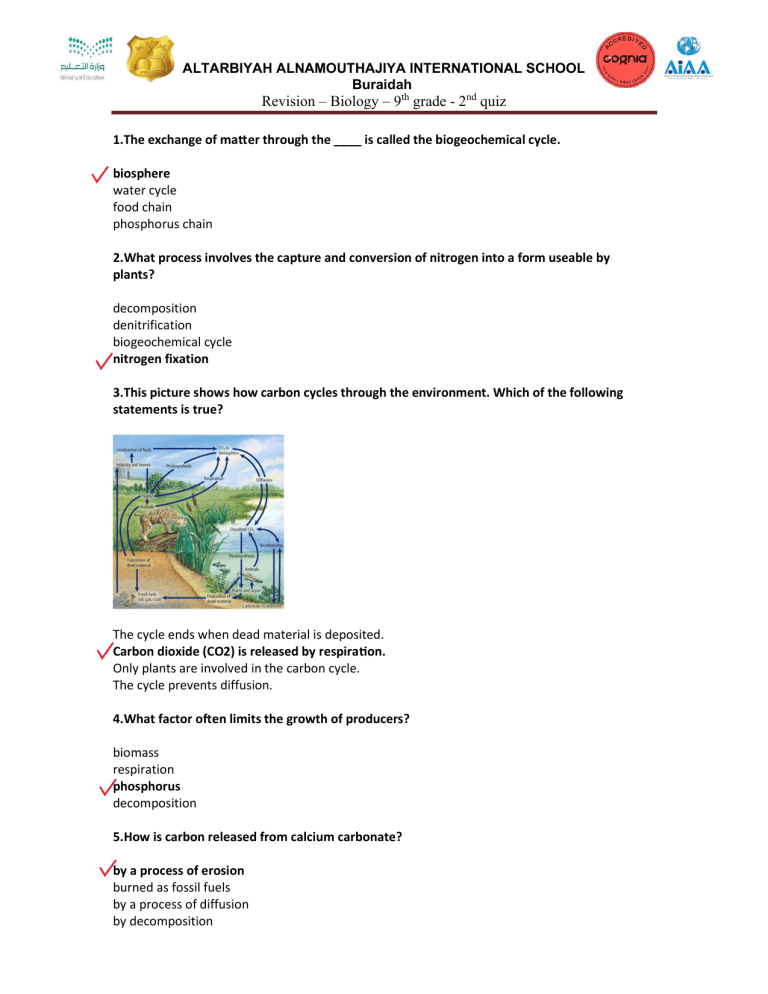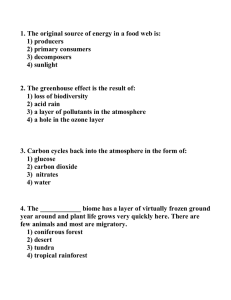
ALTARBIYAH ALNAMOUTHAJIYA INTERNATIONAL SCHOOL Buraidah Revision – Biology – 9th grade - 2nd quiz 1.The exchange of ma er through the ____ is called the biogeochemical cycle. biosphere water cycle food chain phosphorus chain 2.What process involves the capture and conversion of nitrogen into a form useable by plants? decomposition denitrification biogeochemical cycle nitrogen fixation 3.This picture shows how carbon cycles through the environment. Which of the following statements is true? The cycle ends when dead material is deposited. Carbon dioxide (CO2) is released by respira on. Only plants are involved in the carbon cycle. The cycle prevents diffusion. 4.What factor o en limits the growth of producers? biomass respiration phosphorus decomposition 5.How is carbon released from calcium carbonate? by a process of erosion burned as fossil fuels by a process of diffusion by decomposition ALTARBIYAH ALNAMOUTHAJIYA INTERNATIONAL SCHOOL Buraidah Revision – Biology – 9th grade - 2nd quiz 6.A biotic or abiotic factor that restricts the numbers of organisms in an ecosystem is called a tolerating factor limiting factor primary succession end point 7.One community replacing another as a result of changing abiotic and biotic factors is called ecological succession temperate change end point tropical succession 8.Which statement is true based on this picture? Temperature does not affect the physiology of steelhead. Colder water is always better for steelhead survival. Steelhead cannot tolerate temperature above or below a certain limit. There is no upper limit for steelhead temperature tolerance. 9.The first organisms to appear during ecological succession are called ____. succession plants pioneer species end point species primary organisms 10.What is a climax community? stable community with little change in species numbers community consisting of pioneer organisms community left behind immediately after a forest fire community with no biotic factors ALTARBIYAH ALNAMOUTHAJIYA INTERNATIONAL SCHOOL Buraidah Revision – Biology – 9th grade - 2nd quiz 11.The average weather conditions affecting a biome is called ____. temperate condition precipitation tundra climate 12.A ____ is an area where the annual rate of evapora on exceeds the rate of precipita on. desert temperate forest tropical forest polar region 13.What does this picture demonstrate? Increased latitude causes a temperature increase. Increased altitude or latitude causes a temperature decrease. Altitude affects temperature but not latitude. Latitude affects temperature but not altitude. 14.Warm temperatures and large amounts of rainfall characterize what type of biome? boreal forests tundra temperate grassland tropical rain forest 15.How is a boreal forest different from tundra? Boreal forests are colder. There is more permafrost in boreal forests. There are less trees in boreal forests. The ground remains warmer in boreal forests. ALTARBIYAH ALNAMOUTHAJIYA INTERNATIONAL SCHOOL Buraidah Revision – Biology – 9th grade - 2nd quiz 16- By starting on bare rock, what is the usual ecological succession of organisms? grasses → shrubs → lichens → trees lichens → shrubs → grasses → trees grasses → lichens → shrubs → trees lichens → grasses → shrubs → trees 17- which statement concerning the climax stage of ecological succession is correct? it changes rapidly it persists until the environment changes it is the first community to inhabit an area it consists entirely of plants 18- Which of the following is an example of primary succession? A succession of larger plants (trees, shrubs, etc.) following the establishment of pioneer species Plant communities are established in a lifeless environment, usually devoid of soil An ecosystem diversifying, supporting more species, and increases in biomass A transition from one ecosystem type to another 19- Which of the following would NOT contribute significantly to primary succession? The time-consuming process of weathering the bedrock into smaller particles Pre-existing nitrogen-fixing plant communities Wind-carried soil particles and nutrients lichens secreting acid to break down a rock 20- Which of the following is a structural change in a community and its nonliving environment over time that alters the ecosystem? Mutation Evolution Succession Natural selection 21- Which of the following are least likely to be present during primary succession? Moss Grass Trees Lichen ALTARBIYAH ALNAMOUTHAJIYA INTERNATIONAL SCHOOL Buraidah Revision – Biology – 9th grade - 2nd quiz 22- Ecosystems recover from disturbances in unique ways. A landscape ecologist observes in area right after a volcanic eruption. There is lava and dust across the landscape, and all vegetation has been removed. What is this ecosystem experiencing? Primary succession Climax succession Secondary succession community 23- After an event such as a fire or a tree fall in a forest, early successional species are the first to reappear. Which is an example of early successional species? Bears Grasses Shrubs Gorillas 24-26. For each descrip on in ques ons 24-26, select the biome, chosen from the list below, that best fits that description. A biome may be used more than once or not at all. (1) (2) (3) (4) (5) (6) Biomes Tundra Taiga Temperate deciduous forest Grassland Desert Tropical 24- Lichens and mosses are present subsoil permanently frozen. Tundra 25- Constant, warm temperature; plentiful rainfall. Tropical 26- Wide variation in daily temperature; little rainfall. Desert 27- Base your answer to the following question on the diagram below and on your knowledge of biology The lichens and mosses can be classified as a pioneer community abiotic factors a climax community a population ALTARBIYAH ALNAMOUTHAJIYA INTERNATIONAL SCHOOL Buraidah Revision – Biology – 9th grade - 2nd quiz 28- The stable stage that is established in an area as a result of the process of ecological succession is known as the heterotroph community pioneer stage biotic stage climax community 29- The diagram represents the changes in an area over time. This series of changes in the area over hundreds of years is known as evolution feedback ecological succession direct harvesting 30- Which two processes are responsible for keeping the percentage of atmospheric oxygen at relatively constant levels? circulation and coordination respiration and coordination respiration and photosynthesis photosynthesis and circulation 31- Processes involved in the water cycle are represented by letters in the diagram below A-deamination; B-transpiration; C-condensation; D evaporation A-transpiration; B-evaporation; C-condensation; D-precipitation A-condensation; B-precipitation; C-transpiration; D evaporation A-transpiration; B-deamination; C-condensation; D-precipitation ALTARBIYAH ALNAMOUTHAJIYA INTERNATIONAL SCHOOL Buraidah Revision – Biology – 9th grade - 2nd quiz 32- Which two life functions of animals help maintain the water cycle by recycling water back into the environment? digestion and regulation synthesis and locomotion respiration and excretion reproduction and growth Base your answer to the following question on the information below and on your knowledge of biology. Years after the lava from an erupting volcano destroyed an area, lichens started to grow in that area. These were gradually replaced by grasses, shrubs, conifers, and finally, by a deciduous forest. 33- In this sequence of events, the lichens functioned as primary consumers climax organisms abiotic factors pioneer organisms 34- A new island formed by volcanic action may eventually become populated with biotic communities as a result of a decrease in the amount of organic material present decreased levels of carbon dioxide in the area the lack of abiotic factors in the area the process of ecological succession 35- Which gas is released when the tissues of dead plants and animals are broken down by bacteria? NO3 NH3 N2 36- The terrestrial Biome that has annual Precipitation of 200 cm and average annual temperature of 20oC Tropical rainforest Temperate rainforest Temperate seasonal forest Tundra O2 ALTARBIYAH ALNAMOUTHAJIYA INTERNATIONAL SCHOOL Buraidah Revision – Biology – 9th grade - 2nd quiz 37- Which biome would you be in if you saw elephants, giraffes, and lions in the wild? Tundra boral forest desert tropical savanna 38- What biome covers most of Northern Canada? Tundra boral forest desert Taiga Tropical Rainforest savannah 39- What biome covers most of Greenland? Tundra Boreal Forest 40- What biome that has the abiotic factors “hot summers, cold winters, moderate rain fall, fires are possible”? Tundra temperate grassland Tropical Rainforest desert





